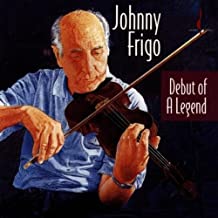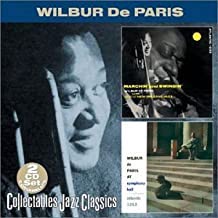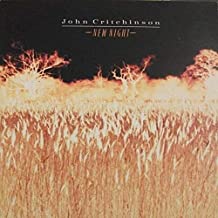
Daily Dose Of Jazz…
Johnny Frigo was born on December 27, 1916 in Chicago, Illinois and studied violin for three years beginning at age seven. In high school he started to play double bass in dance orchestras. In 1942 he played with Chico Marx’s orchestra and performed a comedy routine on violin with Marx on piano.
Entering the United States Coast Guard during World War II, he played in an Ellis Island band with Al Haig and Kai Winding. After his brief turn at active service near the end of the war he moved to New Jersey and from 1945 to 1947 he toured with Jimmy Dorsey’s band. He later formed the Soft Winds trio with Dorsey’s guitarist Herb Ellis and pianist Lou Carter. During this time he wrote the music and lyrics to Detour Ahead and I Told Ya I Love Ya, Now Get Out.
In 1951, returning to Chicago, Johnny primarily worked as a studio bassist and arranger. He also led the band at Mr. Kelly’s, and until 1960 he played fiddle hoedowns and novelties with the Sage Riders, WLS radio house band for the National Barn Dance. Then in 1961 WGN revived the show and he played with the Sage Riders for another fourteen years.
He went on to work with Chicago jazz vocalist Anita O’Day in live and studio recordings. In the mid-1980s Frigo largely abandoned playing bass and concentrated on violin. He performed as a jazz violinist at festivals worldwide. Frigo also was a published poet and artist and played flugelhorn. He wrote and performed the 1969 Chicago Cubs fight song Hey Hey, Holy Mackerel.
Violinist and bassist Johnny Frigo, who was also a composer, lyricist, published poet and artist, passed away of cancer on July 4, 2007 at age 90.
More Posts: composer,history,instrumental,jazz,lyricist,music,piano,violin

Requisites
A Date With Jimmy Smith, Volume One~ Jimmy Smith | By Eddie Carter
Jimmy Smith steps into the spotlight for this morning’s discussion with his 1957 album, A Date With Jimmy Smith, Volume One (Blue Note BLP 1547/BST 81547). This is the first of three large group recordings the organist made for Blue Note, the other two were in 1958, producing the albums, Houseparty and The Sermon and 1960, resulting in Open House and Plain Talk. It’s also the only time he recorded with Donald Byrd (tracks: A1, B1) on trumpet and Hank Mobley (tracks: A1, B1) on tenor sax. Also featured is Lou Donaldson (tracks: A1, B1) on alto sax, Eddie McFadden on guitar, Art Blakey (tracks: A1, B1), and Donald Bailey (track: A2) on drums. The copy used in this report is a friend’s 1966 Liberty Mono reissue sharing the original catalog number.
Falling In Love With Love by Richard Rodgers and Lorenz Hart opens the album with the sextet’s collective uptempo melody. It was first heard in the musical, The Boys From Syracuse (1938). Hank leads off with a smokin’ opening solo, then Eddie puts together a swinging statement. Jimmy dispenses enthusiastic energy on the next presentation. Donald shifts into high gear on the fourth reading. Lou cooks on a delicious solo and Art shares a brief exchange with the front line ahead of the closing chorus. How High The Moon by Nancy Hamilton and Morgan Lewis is a gorgeous jazz standard from the Broadway revue, Two For The Show (1940). This is a trio tune with Bailey taking over the drum chair. Jimmy embraces the melody tenderly and gives two thoughtfully passionate solos. McFadden also has a very gentle reading and Bailey compliments both with elegant brushwork.
Funk’s Oats is a bluesy midtempo original by Jimmy beginning with the sextet stating the melody. Lou leads off this time with a joyously carefree interpretation. Donald extends the happy mood on the second statement. Hank delivers some excellent blowing with an easy swing next. Eddie unfolds the fourth reading as smooth as velvet, and Jimmy takes us into the ensemble’s reprise and exit with a delightful groove. A Date With Jimmy Smith, Volume One was recorded by Rudy Van Gelder, and this Liberty reissue has an outstanding soundstage. The vinyl is quiet for a pressing of this vintage and the instruments emerge from your speakers as if the group is in your listening room. If you’re a jazz fan who enjoys the swinging organ of Jimmy Smith, I offer for your consideration A Date With Jimmy Smith, Volume One. It’s a vibrant, inspired album with everyone in top form that’s sure to make a nice addition to any jazz library!
~ Houseparty (Blue Note BLP 4002/BST 84002), Open House (Blue Note BLP 4269/BST 84269), Plain Talk (Blue Note BST 84296), The Sermon (Blue Note BLP 4011/BST 84011) – Source: Discogs.com ~ Falling In Love With Love, How High The Moon – Source: JazzStandards.com © 2021 by Edward Thomas Carter
More Posts: choice,classic,collectible,collector,history,instrumental,jazz,music,organ

Daily Dose Of Jazz…
William Fredrick Bean was born on December 26, 1933 into a musical family in Philadelphia, Pennsylvania. His mother played the piano, his father was an amateur singer and guitarist, and his sister sang professionally. He started on guitar at the age of twelve.
His father taught him some of the basics on guitar before he received lessons from Howard Herbert. He went on to study with Dennis Sandole for a year. During the late 1940s and 1950s, he performed at venues in the Philadelphia area, until in the mid-Fifties he moved to New York City and recorded with Charlie Ventura and Red Callender. By 1958 he was moving to the West Coast and settling in Los Angeles, California to record for Decca. In Los Angeles, he worked with Buddy Collette, Paul Horn, John Pisano, Bud Shank, Milt Bernhart, Les Elgart, Herb Geller, Lorraine Geller, Calvin Jackson, and Zoot Sims.
Returning to New York City in 1959 after accepting Tony Bennett’s offer to join his band, Bean remained with Bennett’s band for less than one year. Hal Gaylor, who had been Bennett’s bassist, assembled a trio with Bean and pianist Walter Norris, calling themselves The Trio. They recorded an album for Riverside Records in 1961. Finding it difficult to find work, the trio disbanded shortly after recording.
Bean performed with Stan Getz, Herbie Mann, and John Lewis, recording albums with Mann and Lewis. He co-led six recording albums and another 16 as a sideman. Returning to his hometown of Philadelphia, guitarist Billy Bean retired in 1986, and passed away on February 6, 2012.
More Posts: bandleader,guitar,history,instrumental,jazz,music

Daily Dose Of Jazz…
Edward L. Gibbs was born on December 25, 1908 in New Haven, Connecticut. A student of the great banjoist and bandleader Elmer Snowden, he went back and forth among three different stringed instruments during his career.
Gibbs began his career late in the 1920s, playing with Wilbur Sweatman, Eubie Blake, and Billy Fowler. He played with Edgar Hayes from 1937 and played with him on a tour of Europe in 1938. After a short stint with Teddy Wilson, he joined Eddie South’s ensemble in 1940, and worked later in the decade with Dave Martin, Luis Russell, and Claude Hopkins.
As a bassist, he led his own trio at the Village Vanguard and played in a trio with Cedric Wallace, but returned to banjo in the 1950s during the Dixieland jazz revival. He played and recorded with Wilbur de Paris among others during this time.
After studying with Ernest Hill, he returned to bass in the middle of the 1950s, but played banjo once again in the 1960s during another surge in interest in the Dixieland groups. He played at the World’s Fair in 1965 and in 1969 he played bass and occasionally banjo as a member of Buzzy Drootin’s Jazz Family, which included Herman Autrey, Benny Morton, Herb Hall, Sonny Drootin on piano and Buzzy on drums. Also, in the late ’60s he was part of a group called The Happy Family who featured him on both banjo and bass.
Banjoist, guitarist, and bassist Eddie Gibbs, who retired from active performance in the 1970s, passed away on November 12, 1994.
More Posts: bandleader,banjo,bass,guitar,history,instrumental,jazz,music

Daily Dose Of Jazz…
John William Frank Critchinson was born on December 24, 1934 in London, England. He worked as a part-time musician with Ronnie Scott, Tubby Hayes, and Jimmy Deuchar, among others. In 1979, at the recommendation of his mentor, Bill Le Sage, he became a member of Ronnie Scott’s Quartet until it folded in 1995. During that time, he worked with many visiting American artists, including Chet Baker, George Coleman, James Moody, Joe Henderson and Johnny Griffin.
In the early 1980s, he had an association with the British jazz fusion duo Morrissey–Mullen, appearing on two of their albums. He recorded with Dick Morrissey and was a member of Martin Drew’s Our Band, with Ron Mathewson, Jim Mullen, and Dick Morrissey.
In 1995, he formed a quartet with saxophonist Art Themen, bassist Dave Green and Dave Barry on drums. When Scott died in 1996, Critchinson formed the Ronnie Scott Legacy with Pat Crumly on saxophone and flute. Later in his life, he played and recorded with saxophonist Simon Spillett.
Pianist John Critchinson, who recorded eleven albums as a leader and was affectionately known as Critch, passed away on December 15, 2017.
More Posts: bandleader,history,instrumental,jazz,music,piano



